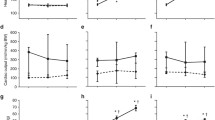Abstract
Renal damage frequently complicates perinatal asphyxia. Renal vasoconstriction due to adenosine metabolite leads to a fall in glomerular filtration rate (GFR) and filtration fraction. This might be inhibited by the nonspecific adenosine receptor antagonist, theophylline. This study was designed to determine whether theophylline could prevent and/or ameliorate renal dysfunction in term neonates with perinatal asphyxia. We randomized 40 severely asphyxiated term infants to receive intravenously a single dose of either theophylline (5 mg/kg; study group: n=20) or placebo (control group: n=20) during the first hour of life. Fluid intake, urine output, serum creatinine, creatinine clearance, GFR, urinary β2 microglobulin (β2 M) and sodium excretion were recorded during the first 5 days of life. The two groups were comparable. No significant difference was reported regarding mechanical ventilatory support, respiratory complications and seizures. Severe renal dysfunction was significantly higher in the control group. Serum creatinine values were less, and creatinine clearance and GFR were significantly higher in the theophylline group from the second day onwards. β2 M excretion was significantly less in the theophylline group, while sodium excretion and hematuria showed no significant difference. Prophylactic theophylline treatment, given early after birth, has beneficial effects in reducing the renal involvement in asphyxiated full-term infants, with no significant changes in central nervous system involvement.
Similar content being viewed by others
References
Saugstad OD (1998) Practical aspects of resuscitating asphyxiated newborn infants. Eur J Pediatr 157:S11–S15
Willis F, Summers J, Minutillo C, Hewitt I (1997) Indices of renal tubular function in perinatal asphyxia. Arch Dis Child Fetal Neonatal Ed 77:F57–F60
Behrman RE, Lees MH, Peterson EN (1970) Distribution of the circulation in the normal and asphyxiated fetal primate. Am J Obstet Gynecol 108:956–969
Rudolph AM (1984) The fetal circulation and its response to stress. J Dev Physiol 6:11–19
Gunn AJ, Gluckman PD, Gunn TR (1998) Selective head cooling in newborn infants after perinatal asphyxia: a safety study. Pediatrics 102:885–892
Di Pietro A, Proverbio MR, Pescatore L (1989) English translation: evaluation of kidney damage in neonatal anoxia syndrome: a 1-year follow-up. Pediatr Med Chir 11:637–638
Churchill PC, Bidani AK (1982) Hypothesis: adenosine mediates hemodynamic changes in renal failure. Med Hypotheses 8:275–285
Gouyon JB, Guignard JP (1988) Theophylline prevents the hypoxemia-induced renal hemodynamic changes in rabbits. Kidney Int 33:1078–1083
Burke TJ, Arnold PE, Gordon JA, Bulger RE (1984) Protective effect of intrarenal calcium membrane blockers before or after renal ischemia: functional, morphological, and mitochondrial studies. J Clin Invest 74:1830–1841
Wiesel PH, Semmekrot BA, Grigoras O (1990) Pharmacological doses of atrial natriuretic peptide ameliorate the acute renal dysfunction induced by systemic hypoxemia. J Pharmacol Exp Ther 254:971–975
Osswald H (1975) Renal effects of adenosine and their inhibition by theophylline in dogs. Naunyn Schmiedebergs Arch Pharamcol 288:79–86
Jenik AG, Ceriani Cernadas JM, Gorensterin A, Ramirez JA et al. (2000) A randomized, double-blind, placebo-controlled trial of the effects of prophylactic theophylline on renal function in term neonates with perinatal asphyxia. Pediatrics 105:e45
Hall JE, Granger JP, Hester RL (1985) Interactions between adenosine and angiotensin II in controlling glomerular filtration. Am J Physiol 248:F340–F346
Gouyon JB, Guignard JP (1988) Functional renal insufficiency: role of adenosine. Biol Neonate 53:237–242
Edlund A, Ohlsen H, Sollevi A (1994) Renal effects of local infusion of adenosine in man. Clin Sci 87:143–149
Prada J, Churchill P, Bidani A (1986) Protective effect of theophylline in endotoxin-mediated acute renal failure (ARF) in rats. Kidney Int 29:308
Deray G, Martinez F, Cacoub P, Baumelou B, Baumelou A, Jacobs C (1990) A role for adenosine calcium and ischemia in radiocontrast-induced intrarenal vasoconstriction. Am J Nephrol 10:316–322
Erley CM, Duda SH, Schlepckow S (1994) Adenosine antagonist theophylline prevents the reduction of glomerular filtration rate after contrast media application. Kidney Int 45:1425–1431
Huet F, Semama D, Grimaldi M, Guignard JP, Gouyon JB (1995) Effects of theophylline on renal insufficiency in neonates with respiratory distress syndrome. Intensive Care Med 21:511–514
Huber W, Ilgmann K, Page M, Hennig M (2002) Effect of theophylline on contrast material-nephropathy in patients with chronic renal insufficiency: controlled, randomized, double-blinded study. Radiology 223:772–779
Kramer BK, Preuner J, Ebenburger A (2002) Lack of renoprotective effect of theophylline during aortocoronary bypass surgery. Nephrol Dial Transplant 17:910–915
Kelly DH, Shannon DC (1981) Treatment of apnea and excessive periodic breathing in the full-term infant. Pediatrics 68:183–186
Gouyon JB, Guignard JP (1987) Renal effects of theophylline and caffeine in newborn rabbits. Pediatr Res 21:615–618
Laudignon N, Farri E, Beharry K, Rex J, Aranda JV (1990) Influence of adenosine on cerebral blood flow during hypoxic hypoxia in the newborn piglet. J Appl Physiol 68:1534–1541
Scheinberg P (1976) Correlation of brain monoamines and energy metabolism changes. In: American Neurological Association, American Heart Association: Stroke Council, Princeton Conference (1976). Cerebrovascular diseases. Raven Press, New York, pp 167–171
Bona E, Ådén U, Fredholm BB, Hagberg H (1995) Reduction of neonatal hypoxic-ischemic brain damage after acute adenosine antagonist treatment. Pediatr Res 37:376A
Gidday JM, Fitzgibbons JC, Shah AR, Kraujalis MJ, Park TS (1995) Reduction in cerebral ischemic injury in the newborn rat by potentiation of endogenous denosine. Pediatr Res 38:306–311
Dux E, Fastbom J, Ungerstedt U, Rudolphi K, Fredholm BB (1990) Protective effect of adenosine and a novel xanthine derivative propentofylline on the cell damage after bilateral carotid occlusion in the gerbil hippocampus. Brain Res 516:248–256
Author information
Authors and Affiliations
Rights and permissions
About this article
Cite this article
Bakr, A.F. Prophylactic theophylline to prevent renal dysfunction in newborns exposed to perinatal asphyxia—a study in a developing country. Pediatr Nephrol 20, 1249–1252 (2005). https://doi.org/10.1007/s00467-005-1980-z
Received:
Revised:
Accepted:
Published:
Issue Date:
DOI: https://doi.org/10.1007/s00467-005-1980-z




